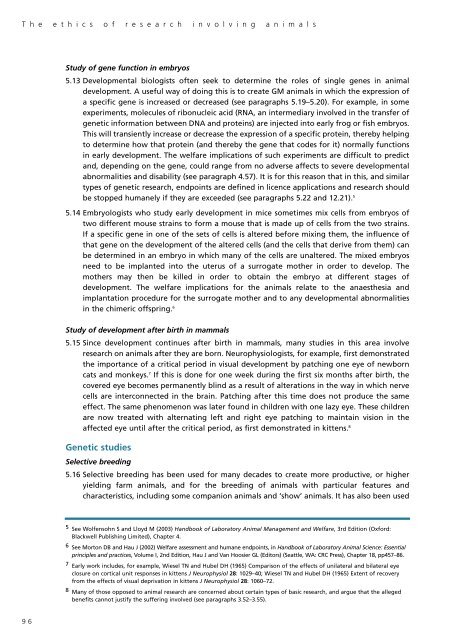The ethics of research involving animals - Nuffield Council on ...
The ethics of research involving animals - Nuffield Council on ...
The ethics of research involving animals - Nuffield Council on ...
You also want an ePaper? Increase the reach of your titles
YUMPU automatically turns print PDFs into web optimized ePapers that Google loves.
T h e e t h i c s o f r e s e a r c h i n v o l v i n g a n i m a l s<br />
Study <str<strong>on</strong>g>of</str<strong>on</strong>g> gene functi<strong>on</strong> in embryos<br />
5.13 Developmental biologists <str<strong>on</strong>g>of</str<strong>on</strong>g>ten seek to determine the roles <str<strong>on</strong>g>of</str<strong>on</strong>g> single genes in animal<br />
development. A useful way <str<strong>on</strong>g>of</str<strong>on</strong>g> doing this is to create GM <str<strong>on</strong>g>animals</str<strong>on</strong>g> in which the expressi<strong>on</strong> <str<strong>on</strong>g>of</str<strong>on</strong>g><br />
a specific gene is increased or decreased (see paragraphs 5.19–5.20). For example, in some<br />
experiments, molecules <str<strong>on</strong>g>of</str<strong>on</strong>g> rib<strong>on</strong>ucleic acid (RNA, an intermediary involved in the transfer <str<strong>on</strong>g>of</str<strong>on</strong>g><br />
genetic informati<strong>on</strong> between DNA and proteins) are injected into early frog or fish embryos.<br />
This will transiently increase or decrease the expressi<strong>on</strong> <str<strong>on</strong>g>of</str<strong>on</strong>g> a specific protein, thereby helping<br />
to determine how that protein (and thereby the gene that codes for it) normally functi<strong>on</strong>s<br />
in early development. <str<strong>on</strong>g>The</str<strong>on</strong>g> welfare implicati<strong>on</strong>s <str<strong>on</strong>g>of</str<strong>on</strong>g> such experiments are difficult to predict<br />
and, depending <strong>on</strong> the gene, could range from no adverse affects to severe developmental<br />
abnormalities and disability (see paragraph 4.57). It is for this reas<strong>on</strong> that in this, and similar<br />
types <str<strong>on</strong>g>of</str<strong>on</strong>g> genetic <str<strong>on</strong>g>research</str<strong>on</strong>g>, endpoints are defined in licence applicati<strong>on</strong>s and <str<strong>on</strong>g>research</str<strong>on</strong>g> should<br />
be stopped humanely if they are exceeded (see paragraphs 5.22 and 12.21). 5<br />
5.14 Embryologists who study early development in mice sometimes mix cells from embryos <str<strong>on</strong>g>of</str<strong>on</strong>g><br />
two different mouse strains to form a mouse that is made up <str<strong>on</strong>g>of</str<strong>on</strong>g> cells from the two strains.<br />
If a specific gene in <strong>on</strong>e <str<strong>on</strong>g>of</str<strong>on</strong>g> the sets <str<strong>on</strong>g>of</str<strong>on</strong>g> cells is altered before mixing them, the influence <str<strong>on</strong>g>of</str<strong>on</strong>g><br />
that gene <strong>on</strong> the development <str<strong>on</strong>g>of</str<strong>on</strong>g> the altered cells (and the cells that derive from them) can<br />
be determined in an embryo in which many <str<strong>on</strong>g>of</str<strong>on</strong>g> the cells are unaltered. <str<strong>on</strong>g>The</str<strong>on</strong>g> mixed embryos<br />
need to be implanted into the uterus <str<strong>on</strong>g>of</str<strong>on</strong>g> a surrogate mother in order to develop. <str<strong>on</strong>g>The</str<strong>on</strong>g><br />
mothers may then be killed in order to obtain the embryo at different stages <str<strong>on</strong>g>of</str<strong>on</strong>g><br />
development. <str<strong>on</strong>g>The</str<strong>on</strong>g> welfare implicati<strong>on</strong>s for the <str<strong>on</strong>g>animals</str<strong>on</strong>g> relate to the anaesthesia and<br />
implantati<strong>on</strong> procedure for the surrogate mother and to any developmental abnormalities<br />
in the chimeric <str<strong>on</strong>g>of</str<strong>on</strong>g>fspring. 6<br />
Study <str<strong>on</strong>g>of</str<strong>on</strong>g> development after birth in mammals<br />
5.15 Since development c<strong>on</strong>tinues after birth in mammals, many studies in this area involve<br />
<str<strong>on</strong>g>research</str<strong>on</strong>g> <strong>on</strong> <str<strong>on</strong>g>animals</str<strong>on</strong>g> after they are born. Neurophysiologists, for example, first dem<strong>on</strong>strated<br />
the importance <str<strong>on</strong>g>of</str<strong>on</strong>g> a critical period in visual development by patching <strong>on</strong>e eye <str<strong>on</strong>g>of</str<strong>on</strong>g> newborn<br />
cats and m<strong>on</strong>keys. 7 If this is d<strong>on</strong>e for <strong>on</strong>e week during the first six m<strong>on</strong>ths after birth, the<br />
covered eye becomes permanently blind as a result <str<strong>on</strong>g>of</str<strong>on</strong>g> alterati<strong>on</strong>s in the way in which nerve<br />
cells are interc<strong>on</strong>nected in the brain. Patching after this time does not produce the same<br />
effect. <str<strong>on</strong>g>The</str<strong>on</strong>g> same phenomen<strong>on</strong> was later found in children with <strong>on</strong>e lazy eye. <str<strong>on</strong>g>The</str<strong>on</strong>g>se children<br />
are now treated with alternating left and right eye patching to maintain visi<strong>on</strong> in the<br />
affected eye until after the critical period, as first dem<strong>on</strong>strated in kittens. 8<br />
Genetic studies<br />
Selective breeding<br />
5.16 Selective breeding has been used for many decades to create more productive, or higher<br />
yielding farm <str<strong>on</strong>g>animals</str<strong>on</strong>g>, and for the breeding <str<strong>on</strong>g>of</str<strong>on</strong>g> <str<strong>on</strong>g>animals</str<strong>on</strong>g> with particular features and<br />
characteristics, including some compani<strong>on</strong> <str<strong>on</strong>g>animals</str<strong>on</strong>g> and ‘show’ <str<strong>on</strong>g>animals</str<strong>on</strong>g>. It has also been used<br />
5 See Wolfensohn S and Lloyd M (2003) Handbook <str<strong>on</strong>g>of</str<strong>on</strong>g> Laboratory Animal Management and Welfare, 3rd Editi<strong>on</strong> (Oxford:<br />
Blackwell Publishing Limited), Chapter 4.<br />
6 See Mort<strong>on</strong> DB and Hau J (2002) Welfare assessment and humane endpoints, in Handbook <str<strong>on</strong>g>of</str<strong>on</strong>g> Laboratory Animal Science: Essential<br />
principles and practices, Volume I, 2nd Editi<strong>on</strong>, Hau J and Van Hoosier GL (Editors) (Seattle, WA: CRC Press), Chapter 18, pp457–86.<br />
7 Early work includes, for example, Wiesel TN and Hubel DH (1965) Comparis<strong>on</strong> <str<strong>on</strong>g>of</str<strong>on</strong>g> the effects <str<strong>on</strong>g>of</str<strong>on</strong>g> unilateral and bilateral eye<br />
closure <strong>on</strong> cortical unit resp<strong>on</strong>ses in kittens J Neurophysiol 28: 1029–40; Wiesel TN and Hubel DH (1965) Extent <str<strong>on</strong>g>of</str<strong>on</strong>g> recovery<br />
from the effects <str<strong>on</strong>g>of</str<strong>on</strong>g> visual deprivati<strong>on</strong> in kittens J Neurophysiol 28: 1060–72.<br />
8 Many <str<strong>on</strong>g>of</str<strong>on</strong>g> those opposed to animal <str<strong>on</strong>g>research</str<strong>on</strong>g> are c<strong>on</strong>cerned about certain types <str<strong>on</strong>g>of</str<strong>on</strong>g> basic <str<strong>on</strong>g>research</str<strong>on</strong>g>, and argue that the alleged<br />
benefits cannot justify the suffering involved (see paragraphs 3.52–3.55).<br />
96
















